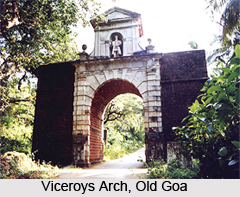 Viceroy`s Arch was build by Viceroy Francisco da Gama, the grandson of Vasco da Gama in 1597 in Old Goa. The main road in front of the Church of St. Cajetan leads to Mandovi River through an archway known as the Viceroy`s Arch. The deer crest of the De Gama family can be seen on the rebuilt arch that now stands on the original site. The original structure was built after the conquest of the city by the Portuguese. The arch had collapsed in 1948 and was completely re-built in 1954. It thus went under considerable changes. It is embellished with delicate floral designs that fascinate its visitors.
Viceroy`s Arch was build by Viceroy Francisco da Gama, the grandson of Vasco da Gama in 1597 in Old Goa. The main road in front of the Church of St. Cajetan leads to Mandovi River through an archway known as the Viceroy`s Arch. The deer crest of the De Gama family can be seen on the rebuilt arch that now stands on the original site. The original structure was built after the conquest of the city by the Portuguese. The arch had collapsed in 1948 and was completely re-built in 1954. It thus went under considerable changes. It is embellished with delicate floral designs that fascinate its visitors.
Architecture of Viceroy`s Arch
The architecture of Viceroy`s Arch looks very appealing. The arch is built of laterite stone with the side facing the river constructed of green granite. On top of the arch facing the Mandovi River is a small statue of Vasco da Gama, fully dressed in his royal uniform. There is also a Gothic inscription of Vasco Da Gama within the arch. The inscription relates that the arch was rebuilt by Governor Francisco Da Gama in the memory of his great grandfather, Vasco Da Gama. Another inscription on it is dedicated to the Immaculate Conception of Virgin Mary, commemorating the liberation of Portugal from Spain in 1656. There us another statue of the Argonaut in the rear. There are two inscribed slabs alongside the walls in the arch.
The original structure of Viceroy`s Arch was erected after the conquest of the city by the Portuguese. However, it later underwent considerable changes. When it was rebuilt in 1954 the statues excluding the bronze statue of St. Catherine were preserved. The statue of St. Catherine was at the top of the structure in a separate niche.
The main gate is an excellent example of Maneuline style of architecture, though the arch in itself is a feature of the Italian renaissance. While the arch was re-built, the restoration of the third tier that contained the statue of St Catherine made of bronze was omitted. It is now in the courtyard of the museum. On the reverse side of the archway there is a statue of a crowned woman standing on a "native", symbolizing the "Christian victory over paganism". Tradition has it that on taking office, all viceroys are supposed to pass under the arch where they would be given the ceremonial key to the city and Goa. The road under the arch is known as Rua Direita. This road connects to the main road leading to other famous monuments of Goa.



















